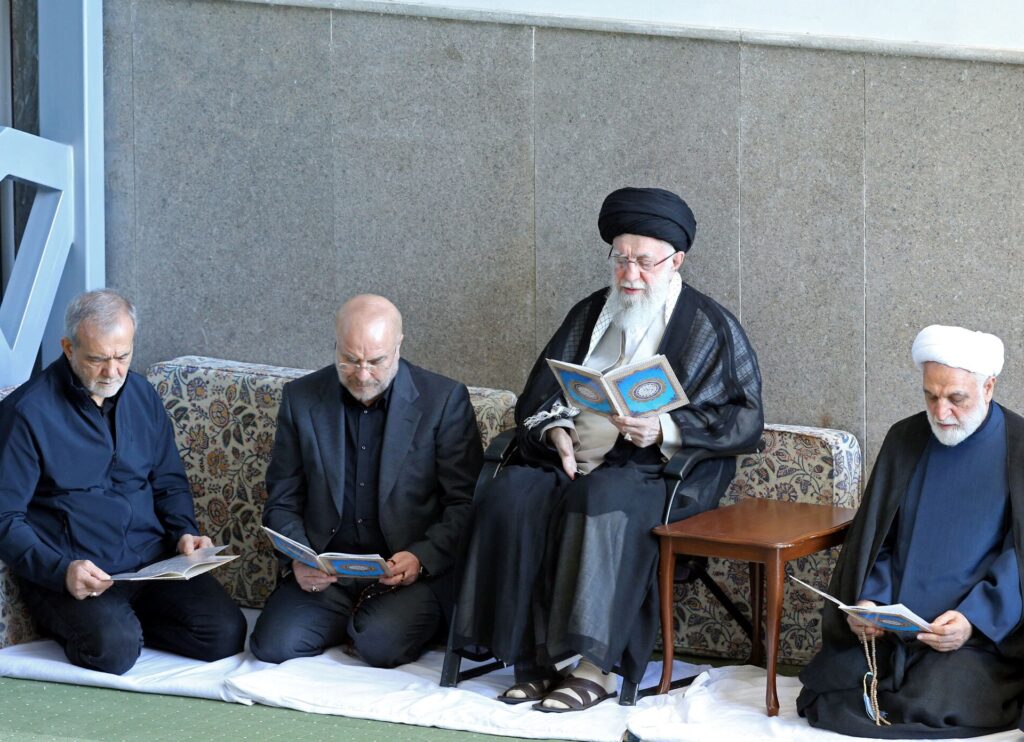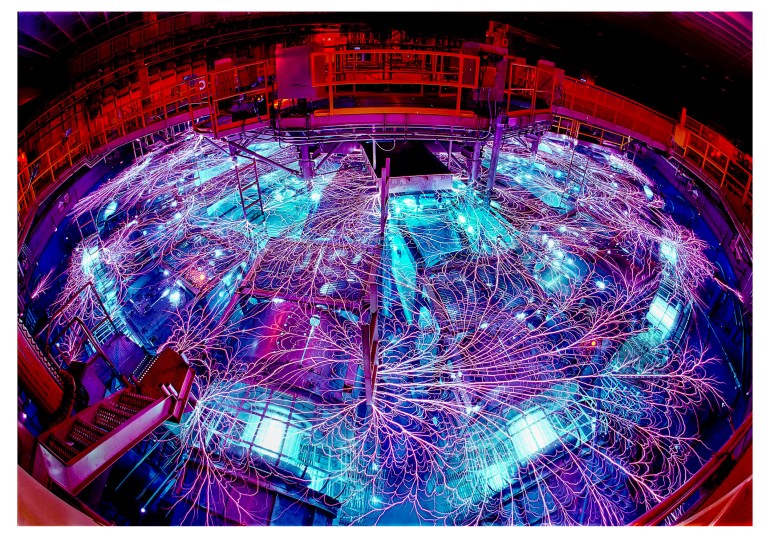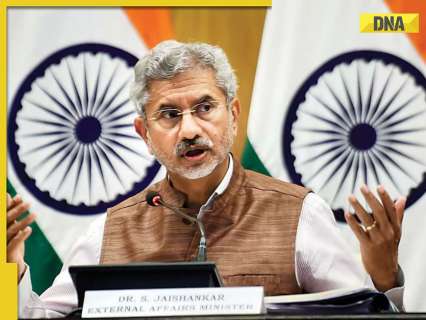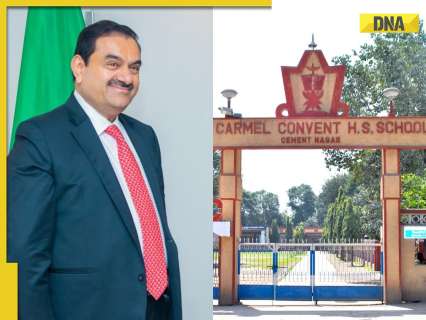Khamenei says Iran and its allies will not back down from Israeli attacks

Iran’s Supreme Leader Ayatollah Ali Khamenei has said Iran and its regional allies will not back down against Israel and called for unity among Muslim nations as he delivered a rare Friday sermon. Khamenei led prayers at the Imam Khomeini Grand Mosalla mosque in central Tehran in his first public appearance since Iran launched a massive barrage of some 200 ballistic missiles at Israel on Tuesday. That attack was in retaliation for Israel’s killings of senior Hezbollah, Hamas and Iran’s Islamic Revolutionary Guard Corps (IRGC) figures, including Hezbollah leader Hassan Nasrallah, and escalating attacks in Lebanon. “The resistance in the region will not back down even with the killing of its leaders,” Khamenei said, calling Iran’s attack on Israel “legal and legitimate”. “The operations were … in return for the heinous crimes committed by this bloodthirsty criminal entity,” he said. He said Iran would fulfil its “duty” to allies in a considered manner. “We will not act irrationally … not act impulsively”, he said, adding that the country would follow decisions “handed down by our political and military leadership”. Reporting from Tehran, Al Jazeera’s Resul Serdar said the event was being held at a “delicate and intense time”. Khamenei’s sermon sent a message to Israel that the Iranian authorities “are not hiding, they are not seeking shelter, they are not going underground”, Serdar said. It was the supreme leader’s first such sermon in more than four years, coming just before the first anniversary of Hamas’s October 7 attack on Israel, which led to a war that has so far killed more than 41,700 Palestinians and recently spilled over into Lebanon. Iran’s proxies in its “axis of resistance” – Hezbollah, Yemen’s Houthis and armed groups in Iraq – have carried out attacks in the region in support of the Palestinians in the Gaza war. Addressing massive crowds, Khamenei issued a rallying call to Muslim nations – “from Afghanistan to Yemen, from Iran to Gaza and Lebanon” – saying they should unite against common “enemy” Israel, which he claimed had deployed “psychological”, “economic” and “military” warfare against them. “Our enemy is one,” he said. “If their policies are sowing the seeds of division in one country, they may prevail and once they seize control of one country, they move to the other.” Al Jazeera’s Serdar said that the message of unity countered “criticism over the past decade” that Iran had been isolating itself from the region. “His speech was focused on unity because he has seen now that the possibility of a regional war is real and that’s why he is asking Muslims to be united, to somehow eliminate this threat as a common action, so a regional war can be aborted.” Khamenei last led Friday prayers after the United States killed revered general Qassem Soleimani in Baghdad in 2020. His speech on Friday was preceded by a commemoration for Nasrallah, killed last week in the southern suburbs of Beirut in an Israeli strike, alongside Abbas Nilforoushan, a general from the Islamic Revolutionary Guard Corps. On Tuesday, Israel launched a ground offensive in southern Lebanon, an expansion of the war that has seen it repeatedly bomb Beirut and its southern suburbs. Later that same day, Iran made a retaliatory attack on Israel, its second this year. In April, it had sent a volley of missiles following a deadly Israeli strike on Iran’s consulate in Damascus. In both attacks, nearly all missiles were intercepted by Israel or its allies, according to Israeli authorities. Early on Friday, Israel hit Beirut with a barrage of attacks reportedly targeting senior Hezbollah figure Hashem Safieddine, a putative successor to Nasrallah. There was no comment from Israel or Hezbollah on his fate. Tehran has told the US via an intermediary that any Israeli attack against Iran would meet an “unconventional response” that includes targeting infrastructure, according to an Iranian official who spoke to Al Jazeera. US President Joe Biden said on Thursday that Israel’s response could include a strike on Iran’s oil facilities. Adblock test (Why?)
No place for foreign workers being displaced in Lebanon

Beirut, Lebanon – Over the last 11 months, as air raids hit villages near their home, Lakmani and her mother Sonia decided to stay in their south Lebanese village of Jouaiya, about a 25-minute drive east of Tyre and a little under an hour from the southern border. “There were some raids not far away,” Lakmani, 26, said. “And they broke the sound barrier a few times,” her 45-year-old mother Sonia added. Sonia came from Sri Lanka to Lebanon to work as a cleaner shortly before giving birth to Lakmani, who has lived her whole life in Lebanon and works as a private tutor. “But then Monday bombs started falling and we said: ‘OK, we should go,’” Lakmani told Al Jazeera, sitting on a park bench in downtown Beirut, where she and her mother now sleep. That day, September 23, would go on to become the deadliest day since the end of the country’s civil war in 1990. Israeli bombs rained down on villages in the south and the Bekaa Valley in the east of Lebanon, killing at least 550 people. Lakmani and Sonia gathered a few belongings, mostly clothes, and fled to Tyre, thinking they would be safe there. But after three days, the air raids around Tyre were so violent that they decided to move north to Beirut. On Friday, September 27, the Israeli military sent evacuation orders for large parts of Beirut’s southern suburbs, creating a displacement crisis in the capital. They, like other foreign workers in Lebanon, are now sleeping rough. Lakmani and her mother found space in a small, grassy public garden with a few trees next to a busy street in Saifi, near Martyrs’ Square in downtown Beirut. About 102,000 people had already been displaced in the last 11 months. Now that figure is about one million, according to the United Nations Office for the Coordination of Humanitarian Affairs (OCHA). A gross underestimation The Education Ministry opened shelters for the displaced in schools around the country but limited them to displaced Lebanese citizens. Those without Lebanese nationality, and many with it, have taken refuge by Beirut’s seaside or in public spaces. Zeinab from Sudan holds her newborn baby girl in a temporary shelter for migrants at St Joseph Church in Beirut on October 1, 2024 [Louisa Gouliamaki/Reuters] The International Organization for Migration estimates about 176,500 migrants live in Lebanon, though the real number is thought to be much higher. A regularly cited figure is about 200,000 but even that is a “gross underestimation”, according to experts and activists in the sector. Many of them work as cleaners or nannies and are beholden to the country’s kafala labour system, which binds a foreign worker to a local sponsor and often results in the labourer being abused. The recent Israeli attacks have highlighted the vulnerability of these foreign workers. Activists who specialise in working with them told Al Jazeera that the war has left them in a variety of troubling situations. “Some of them were left behind in their [employers’] houses in targeted areas, mainly in south Lebanon or the Bekaa region and they had to find their way back to safe areas often without passports or papers,” Diala Ahwash, a Lebanese migrant rights activist, told Al Jazeera. Others were brought to safe areas by their employers but then left on the streets, being forced to sleep rough in parks or by Beirut’s seaside. Some were taken to temporary shelters but then expelled when administrators decided to give places to Lebanese instead. “There’s no understanding that these women have rights. [This situation] goes back to kafala and how it operates, turning migrant domestic workers into an accessory or commodity,” Salma Sakr, of the Anti-Racism Movement (ARM), told Al Jazeera. “And when you don’t need this commodity you throw it away in the street.” “Basically the majority of migrant workers are now facing a precarious situation in varying degrees but it’s a disaster in a general sense,” Ahwash said. There’s no place without war As the war expanded, some embassies began extracting their citizens. The Philippines embassy repatriated its citizens without charging them. Others are making their citizens pay, and many foreign labourers are on low wages and cannot afford expensive plane tickets home. Then there are citizens of countries that have an honorary consulate instead of an embassy in Lebanon. Many embassies do not want to pay to repatriate their citizens, demanding that the people pay for their evacuations themselves [Courtesy of Dara Foi’Elle, Migrant Workers’ Action] “These consulates are completely useless and some exploit workers in this situation and make them pay more,” Sakr said. “With the embassies, there’s a higher-level response.” But, Sakr added, many embassies still require citizens to pay their way home. In the park in Saifi, Rose, 30, sat with two of her Ethiopian compatriots. All were living in Beirut’s southern suburbs until last Friday when Israel began sending evacuation orders. Rose has been in Lebanon for 12 years. She works as a freelancer and lives in her own place with her Sudanese husband and two children. “Everyone comes here to speak to us but what do we benefit from these interviews?” she said, her fatigue showing through. She said she could not afford to pay for evacuation but even if she could, “My husband is from Sudan and I’m from Ethiopia. There’s no place without war.” Some nationals from countries enduring ongoing conflicts – Syria, Sudan, Ethiopia, and others – can register with UNHCR and apply for resettlement, though “the process takes years and years and serves a very small population,” Sakr said. “So it’s not really a sustainable situation.” The Lebanese government has also been of little help, according to activists. In some cases, Lebanon’s General Security, which is responsible for border control, has levelled fines in the hundreds or thousands of dollars on workers with expired papers. Most workers make at most a few hundred dollars a month. “As Lebanon is facing relentless, indiscriminate attacks, it is
Was Bruce Willis right? Could a nuclear blast save us from killer asteroid?

It’s been almost 25 years since Bruce Willis, playing the fictional character Harry Stamper in the blockbuster movie, Armageddon, saved Earth from an asteroid careering towards the planet. In true Hollywood fashion, he did this by detonating a nuclear bomb implanted in the asteroid, preventing what scientists call a “mass extinction event”. The whole world cheered (at least in the movie). The world might be able to cheer for real now. In a study published in Nature Physics, physicists at Sandia National Laboratories in New Mexico, US, say they have simulated a nuclear X-ray pulse directed onto the side of an asteroid to change the trajectory of the asteroid and avoid a collision with the Earth. How did the experiment work? In a recent experiment conducted at Sandia National Laboratories, researchers used a Z machine to generate the X-ray pulses. This is one of the world’s most powerful radiation machines that can generate magnetic fields and X-rays. To generate the X-ray pulse, an intense electrical burst is directed at a pocket of argon gas. This triggers an implosion of the argon gas and turns it into plasma. The plasma emits a powerful surge of X-rays towards the target, effectively mimicking a nuclear detonation in space. The world’s largest pulse-powered accelerator – the Z Machine housed at Sandia [Handout/Sandia National Laboratories] Scientists used an X-ray pulse inside a vacuum to simulate a nuclear explosion on the surface of an asteroid-like rock in space-like conditions. The pulse created a vapour plume which pushed the rock away. “The vaporised material shoots off one side, pushing the asteroid in the opposite direction,” Dr Nathan Moore, the lead author of the new study, said in a press statement. In an interview with Space.com, an online publication focused on space exploration and astronomy, Moore said: “You have to concentrate a lot of power, about 80 trillion watts, into a very small space, the size of a pencil lead, and very quickly, about 100 billionths of second, to generate a hot enough argon plasma, several millions of degrees, to make a powerful enough X-ray burst to heat the asteroid material surface to tens of thousands of degrees to give it enough push.” He also explained that creating an environment that replicates one in which asteroids move freely through space without anchoring the asteroid-like rock used for the experiment was a challenge. The solution was to use what they called “X-ray scissors”. This involved hanging the rock using extra thin foil wires about one-eighth the thickness of a human hair. “A key fact was that asteroids in outer space aren’t attached to anything. But in a lab, everything is pulled down by Earth’s gravity, so everything is held in place by its gravitational attachment to something else. This wouldn’t let our mock asteroid move with the freedom of one in outer space. And mechanical attachments would create friction that would perturb the mock asteroid’s motion,” Moore said in a press statement. This method allowed the scientists to simulate the effects of a nuclear explosion in a controlled environment. Although only a simulation, the outcome of the experiment suggests that using a nuclear X-ray pulse on an asteroid could potentially change its trajectory enough to prevent a collision with the Earth. “I knew right away that this was a huge success,” said Moore. Does a nuclear X-ray pulse have the same effect as a nuclear blast? There is a significant difference between planting a nuclear bomb on an asteroid and directing a nuclear X-ray pulse to part of an asteroid to nudge it onto a different trajectory. If a space agency were to successfully detonate a nuclear bomb on an asteroid, scientists have cautioned that the asteroid would be likely to break into smaller chunks, potentially causing multiple asteroid impacts on Earth instead of just one. Even if the trajectory of the biggest chunk of the asteroid was changed, there would be no guarantee that the other fragments of the asteroid would travel away from Earth. Using an X-ray pulse, scientists can generate energy to vapourise enough material from the surface of the asteroid to result in a push that would change the trajectory of the asteroid rather than blasting it into smaller fragments. Have we tried to change the trajectory of an asteroid before? Changing the trajectory of an asteroid might appear more fiction than science, but in November 2021, the Double Asteroid Redirection Test (DART) mission by NASA crashed a spacecraft into the asteroid Dimorphos and successfully changed the asteroid’s orbital path. Fortunately, the Dimorphos asteroid was no threat to Earth. It was selected to test whether an impact from another object could be a viable method for deflecting an asteroid. How close do asteroids come to Earth? Last week, 2024 ON asteroid, a Near-Earth Object (NEO) measuring 290m (950 feet) in length, safely passed Earth at a distance of almost 1 million km (621,000 miles), about 2.5 times the distance between the Earth and the moon. NEOs are asteroids or comets that are monitored by ground-based and space-based telescopes to identify potentially hazardous objects, especially those that have the potential to impact Earth. On June 19, 2004, the asteroid 99942 Apophis, appropriately dubbed “God of Destruction”, measuring 370m (1,210 feet) in length, was spotted by astronomers Roy A Tucker, David J Tholen and Fabrizio Bernardi from the Kitt Peak National Observatory in Arizona. At the time, the scientists predicted that Apophis would eventually hit Earth on April 13, 2029. However, new research suggests that the asteroid will do a close fly-by the same day and is expected to pass about 32,000km (19,800 miles) from Earth, closer than some satellites that orbit the planet. On February 23, 2012, asteroid Duende, a NEO roughly 30m (98 feet) in diameter, was discovered by astronomers at the La Sagra Observatory in Spain. Duende made a close approach to Earth, passing at about 27,700km (17,200 miles), even closer than Apophis asteroid. What are the ethical implications of using nuclear energy
Vistara-Air India merger: How to transition flights, handle baggage, access lounges from Nov 12

Vistara will merge with Air India from November 12, 2024, with all flights operating under the Air India banner requiring passengers to update their bookings and travel plans accordingly.
EAM S Jaishankar to travel to Pakistan for SCO Summit 2024 on…

External Affairs minister S Jaishankar to travel to Pakistan for Shanghai Cooperation Organisation (SCO) heads of government meeting.
Senior office bearer reveals what led to Adani’s takeover of Cement Nagar School, says ‘not policy clash, but…’

Adani Foundation earlier said that the transfer process adhered to all required protocols, and approvals from the CBSE and the state government were duly obtained.
‘Kar diya 2024 mein murder…’ Delhi teen shares SHOCKING social media post after killing doctor

According to police, after receiving treatment, the teen shot Dr. Akhtar, reportedly claiming that the doctor had overcharged him for his services.
Maharashtra Deputy Speaker, NCP leaders jump from building, know why

He allegedly jumped from the third floor of the Mantralaya, the administrative headquarters of the Maharashtra Government in Mumbai
Trump to headline NRA event in pivotal swing state two weeks before Election Day

Former President Trump will headline the National Rifle Association’s (NRA) Defend the 2nd event in Savannah, Georgia, Oct. 22, the organization announced Friday morning. “This election is a pivotal one for America’s gun owners. Kamala Harris and her far-left allies have big plans to erode Second Amendment protections,” NRA Vice President and CEO Doug Hamlin said in a statement. “Donald J. Trump has proven himself a fighter for Americans’ right to keep and bear arms. We are excited to have him speak at our Defend the 2nd event and to support his return to the White House in January.” NRA TARGETS SEN SHERROD BROWN IN 7-FIGURE AD BUY IN OHIO Earlier this year, the NRA endorsed Trump in his presidential campaign. Trump also spoke at the NRA’s convention in May. The NRA has been ramping up its attacks on certain Democratic candidates who are softer on gun owners’ rights. Ohio is the second state the NRA Political Victory Fund has targeted this election cycle. Last month, the gun group launched a major radio campaign against vulnerable Democratic Sen. Jon Tester of Montana. NRA BETS BIG ON MONTANA IN GUN RIGHTS PUSH AS TESTER TEETERS IN SENATE RACE “When it comes to preserving and strengthening our constitutional rights in America, the stakes could not be higher in this presidential election,” the NRA’s news release said. “No matter your reason for owning a firearm — whether for hunting, self-defense or just as an exercise of your constitutional right — law-abiding gun owners have a clear choice this fall if they hope to preserve their Second Amendment rights.”
Colin Allred narrows gap in Texas Senate race, but can he win?

The Democratic congressman is polling closer to Sen. Ted Cruz in his challenge this year, and independent race rankers are noticing.
